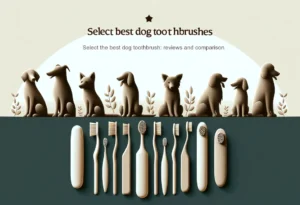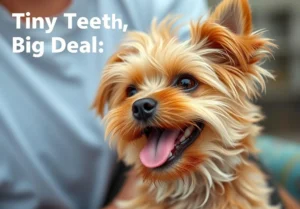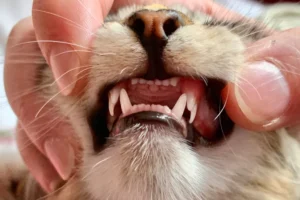Disclosure: We may earn a commission from helpful, relevant links in our content. No cost to you. See our privacy policy.
Every pup owner knows, dogs are not just pets, they’re family.
And as family, we want to give them the best – from the comfiest bed to the most nutritious food. Yet, one aspect often overlooked is dental hygiene.
It might seem trivial, with the array of chew toys and treats that promise to keep your dog’s teeth clean. But here’s the thing – just as we humans need to brush our teeth daily, so do our furry friends. Why, you might ask? What difference does it make?
This post will dive into the importance of dog toothbrushes, help you choose the right one for your pooch, and guide you through the brushing process. As you flip through these pages, remember, it’s not just about the doggy grins but also their long-term health and well-being.
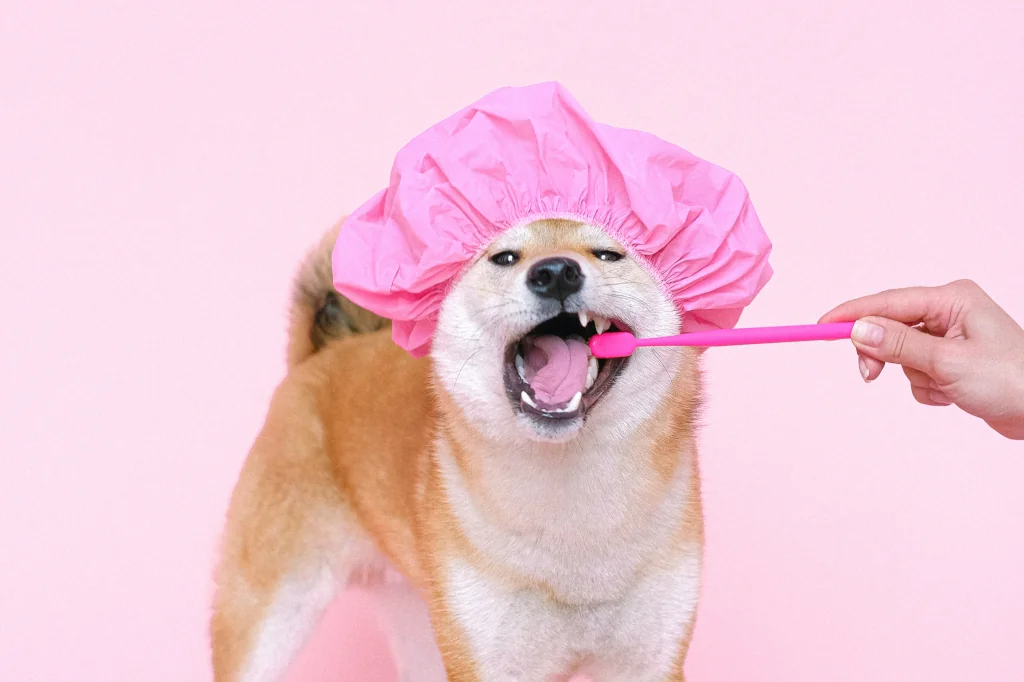
Why Does Your Dog Need a Toothbrush?
Just like humans, dogs can suffer from a plethora of dental issues – gum disease, tooth decay, bad breath, just to name a few.
The build-up of plaque and tartar can lead to painful infections that can spread to the kidneys, heart, and liver. A toothbrush, specifically designed for dogs, helps remove the plaque and prevents the formation of tartar.
Regular brushing not only ensures fresh breath and cleaner teeth but also safeguards your dog’s overall health. And let’s not forget, a healthy pup is a happy pup.
Human vs. Dog Toothbrushes: What’s the Difference?
We often want to share everything with our loved dogs.
But your toothbrush shouldn’t be one of those things. Human and dog toothbrushes are made differently because our mouths aren’t the same.
A human toothbrush is straight and designed for a small, straight mouth. It won’t reach the back teeth of a dog easily. A dog’s toothbrush, however, is angled and often longer to navigate the dog’s broader and more rounded mouth. The bristles are also softer and better arranged to clean around a dog’s rounded teeth and along the gum line.
So, remember, while sharing is caring, when it comes to toothbrushes, it’s best to stick to species-specific ones for the best dental care.
Types of Dog Toothbrushes
Dog toothbrushes come in several types, depending on your needs. We’ll break this down and help you identify the perfect fit for your pup’s pearly whites.
Traditional Dog Toothbrush
The classic choice, the traditional dog toothbrush, comes with an angled handle and bristles specifically designed for a dog’s mouth.
These toothbrushes can have either a single or double head. Double-headed brushes offer a practical approach to simultaneously clean different areas of your pup’s mouth. A smaller head reaches the front teeth, while a larger one works best for the back molars.
A great example of this is the Pet Republique Dog Toothbrush Series, which offers a double-headed design to provide comprehensive cleaning.

Traditional dog toothbrushes should be used if your dog is already comfortable with the tooth-brushing routine.
Finger Toothbrush
Finger toothbrushes are great for beginners, especially for puppies or dogs who are not yet used to the idea of having their teeth brushed.
As the name suggests, this brush slips onto your fingertip, allowing you to have direct tactile feedback. This can be helpful in making sure you’re applying the right amount of pressure and not hurting your furry friend.
The H&H Pets Finger Toothbrush is an excellent choice in this category, made from high-quality material that’s gentle on your dog’s gums but effective in removing plaque.

It provides a sense of control that some dogs find less intimidating than a traditional toothbrush.
Silicone Dog Toothbrush
Silicone dog toothbrushes are like normal brushes, but softer and more comfortable.
They feature a flexible design and gentle bristles, like the Mascota Pets Dog Toothbrush, which is perfect for dogs with sensitive gums or those reluctant to tolerate a toothbrush.

Its malleable structure allows for an efficient cleaning of the teeth and gum line.
Remember to replace silicone brushes more frequently due to their softer structure.
Dental Chew Toothbrush
Last but not least, we have dental chew toothbrushes. These innovative brushes are shaped like chew toys and are made from dog-safe material.
Dental chews have bumps or lines that help clean your dog’s teeth as they chew on them. While not as efficient as an actual toothbrush, they can be a good alternative for dogs who simply refuse a traditional brushing routine.
The KONG Dental Dog Toy is one of the best options in this category, offering an exciting chew toy that doubles up as a toothbrush.

Just keep in mind, dental chews are not a complete substitute for brushing but can help maintain oral hygiene between brushings.
Here’s a table comparing these four types of toothbrushes:
| Type | Best for | Recommended Product |
| Traditional | Comfortable dogs | Pet Republique Series |
| Finger | Beginners, puppies | H&H Pets Finger Toothbrush |
| Silicone | Sensitive gums | Mascota Pets Toothbrush |
| Dental Chew | Refusing traditional brush | KONG Dental Dog Toy |
All these toothbrushes have their strengths and are better suited for different scenarios. It’s all about understanding your dog’s comfort and tolerance level, and their specific dental needs. Remember, consistency is key, and a brush that your dog allows you to use regularly is the best one for you.
How to Choose the Best Toothbrush for Your Dog?
Choosing the right toothbrush for your dog involves considering their size, comfort, and dental health, as well as your own ease of use. This section will take you through the key steps to make it easier for you.
1. Consider the Size of Your Dog
When choosing the right toothbrush, the size of your dog plays a significant role.
For example, I recall the day I decided to introduce tooth brushing to my younger Labrador Retriever, Charlie. I made the mistake of buying a small toothbrush, which was more suited for a Chihuahua than a lively Lab! The small brush didn’t efficiently reach Charlie’s back teeth, and the entire process was far less effective than I had hoped.
So, the rule of thumb here is, larger breeds require a bigger toothbrush with a longer handle, while smaller breeds need smaller brushes for their petite mouths.
2. Assess Your Dog’s Comfort Level
As dog owners, we know that each dog comes with its own set of quirks. Some may tolerate a traditional toothbrush, while others might need a softer approach.
My older German Shepherd, Sam, for instance, took no time adjusting to a traditional toothbrush. But when I tried the same with my neighbor’s anxious rescue pup, it was a no-go.
For sensitive or anxious dogs, a silicone toothbrush or a finger brush may be a more comfortable starting point.
3. Consider Your Dog’s Dental Health
The condition of your dog’s teeth and gums should also influence your choice. If your dog has gum disease or sensitive gums, a softer silicone brush would be more appropriate.
Regularly inspecting your dog’s mouth for signs of gum redness, inflammation, or bad breath can give you clues about what type of brush you should be using.
4. Take Your Own Comfort into Account
Lastly, don’t forget about your comfort. Choose a toothbrush that feels good in your hand and is easy to maneuver.
I remember trying out a dental chew toothbrush with Sam. The idea of letting him do the brushing while enjoying a chew sounded great, but it was clear that this solution didn’t provide as thorough a cleaning as I could give him with a traditional brush.
It’s important to find a balance between what’s best for your dog and what’s manageable for you.
Choosing the right toothbrush for your dog involves a bit of trial and error. It’s about understanding your dog’s needs, size, and personality and matching those with a toothbrush that works for both of you.
Just remember, no matter which toothbrush you choose, consistency is key. A regular brushing routine will keep your pup’s teeth shiny and their overall health in check.
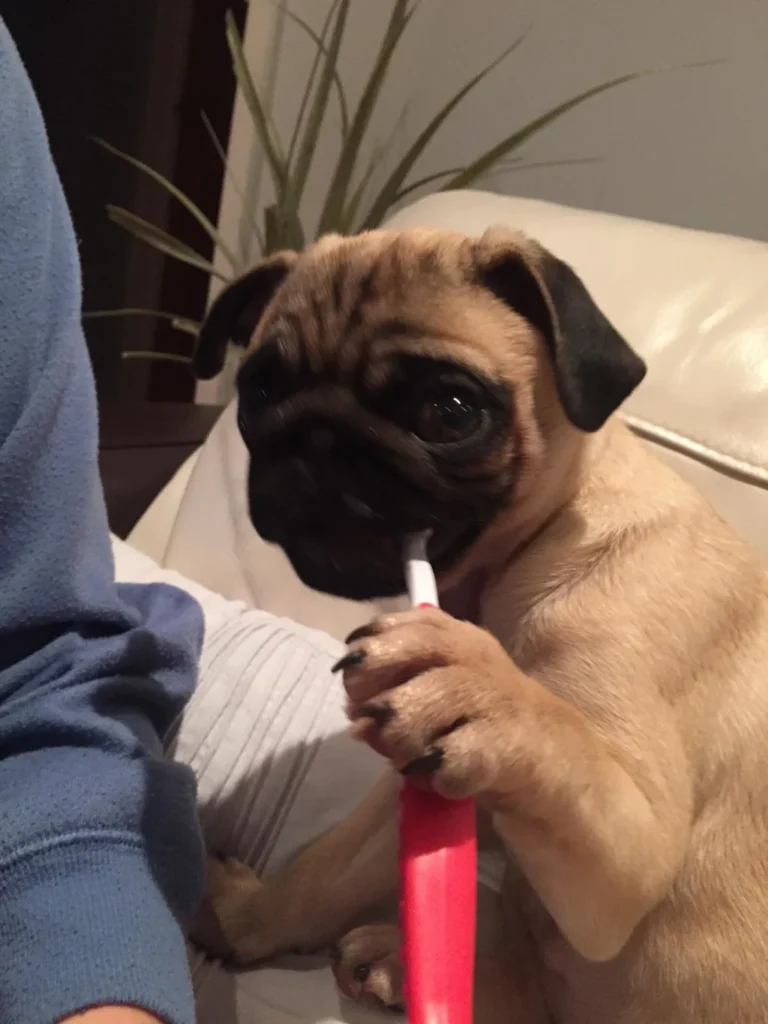
Common Mistakes to Avoid When Brushing Your Dog’s Teeth
Brushing your dog’s teeth is a crucial part of their overall health care. However, many pet owners make common mistakes that can make the process less effective and potentially stressful for their furry friends. In this section, we’ll discuss these common pitfalls and provide practical tips to help you avoid them.
- Rushing the Process. One of the most common mistakes dog owners make is trying to brush all their dog’s teeth at once, especially during the initial stages. It’s essential to start gradually, brushing one or two teeth at a time, to help your dog get accustomed to the process.
- Not Making it Fun. Turning tooth brushing into a positive experience can make the process much smoother. Always end each brushing session on a high note, with a treat, playtime, or a belly rub.
- Not Brushing Regularly. Consistency is key when it comes to maintaining your dog’s dental health. Aim for daily brushing, but if that’s not feasible, a minimum of three times a week is recommended.
- Using the Wrong Toothbrush or Toothpaste. Ensure you choose a dog-friendly toothpaste and a toothbrush that’s the right size and comfort level for your dog.
The goal is to make tooth brushing a stress-free and effective routine for both you and your dog. For a detailed step-by-step guide on how to brush your dog’s teeth, check out our blog post, Guide to Brushing Your Dog Teeth for Beginners.
FAQs
What happens if I don’t brush my dog’s teeth?
Ignoring your dog’s dental hygiene can lead to plaque buildup, gum disease, bad breath, and tooth loss. In severe cases, bacteria from the mouth can enter the bloodstream, potentially damaging the heart, liver, and kidneys.
How often should I replace my dog’s toothbrush?
Your dog’s toothbrush should be replaced every three to four months, or sooner if the bristles start showing signs of wear. Just like with our brushes, worn-out bristles are less effective in cleaning the teeth.
Can I use human toothpaste for my dog?
Human toothpaste is not suitable for dogs due to ingredients like fluoride and xylitol, which can be harmful if swallowed. Always opt for dog-specific toothpaste available at pet supply stores.
Are electric toothbrushes safe for dogs?
Yes, electric toothbrushes can be safe for dogs provided they are used correctly and your dog is comfortable with the vibrations. However, consult with your vet before introducing an electric toothbrush to ensure it’s the right choice for your pet.
Alex, a passionate animal lover, has experience in training and understanding animal behavior. As a proud pet parent to two dogs and three cats, he founded AnimalReport.net to share insights from animal experts and expand his knowledge of the animal kingdom.

